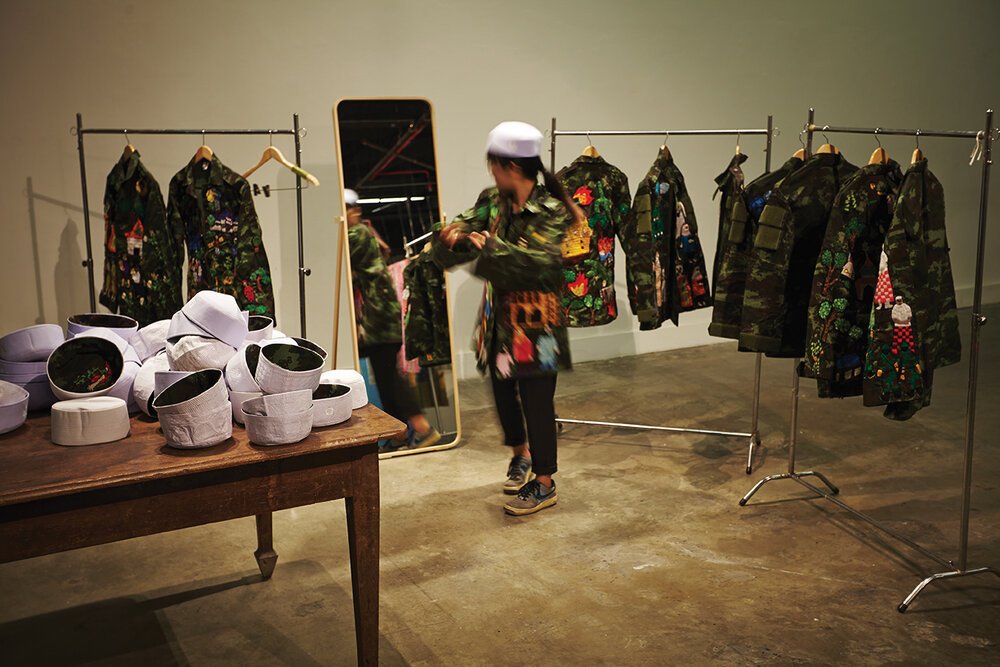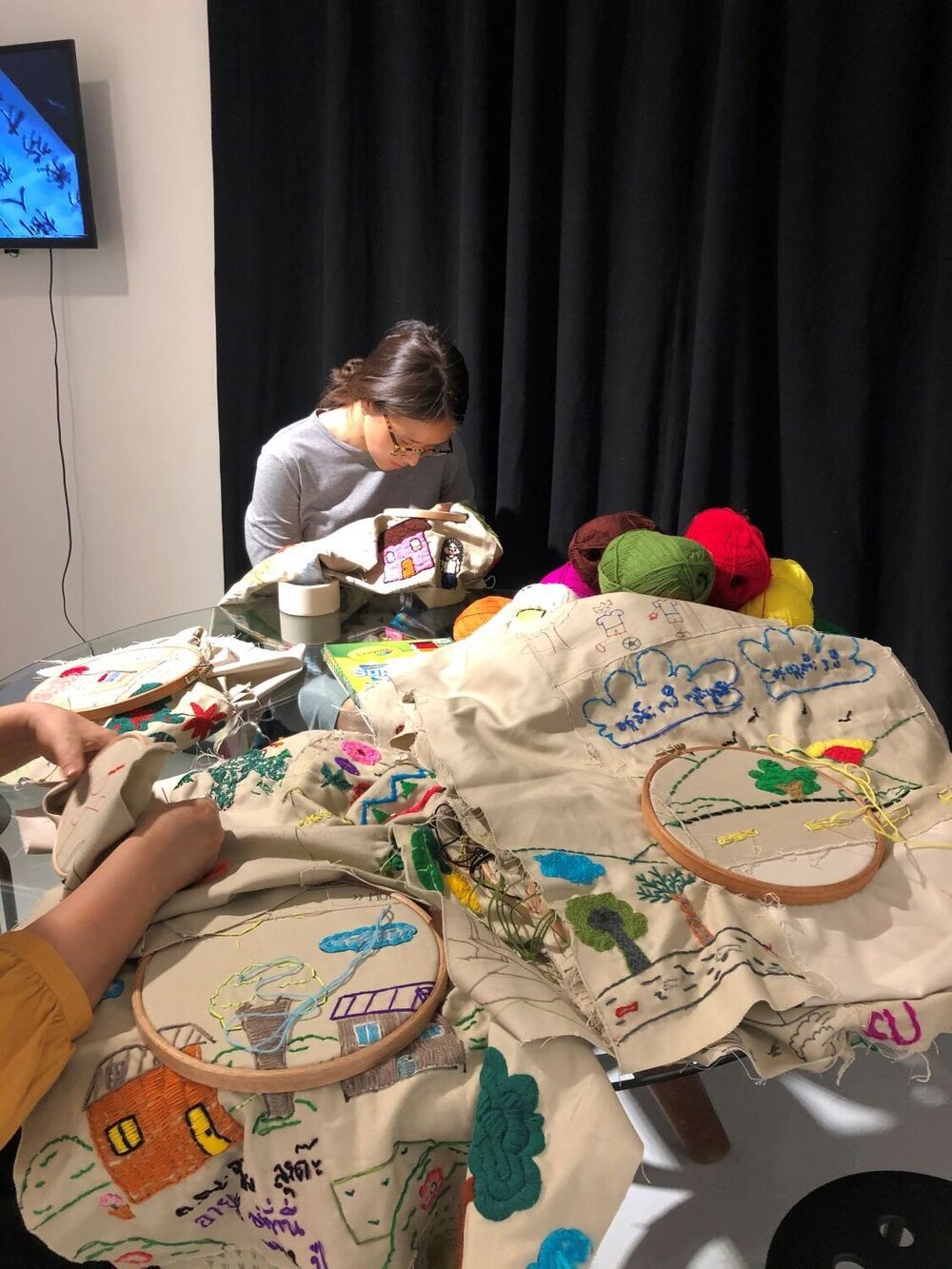We Certainly Shall Not Forget
Confronted histories in the works of Jakkai Siributr
By Blake Palmer
Jakkai Siributr, ‘Changing Room’, 2017, participatory clothing installation, embroidery on Thai military uniforms and Thai Muslim headgear. Image courtesy of the artist.
In his work, Thai artist Jakkai Siributr wrestles with the selective memory that shapes his personal and national history. He uses textile, embroidery and mixed media to bring Thailand’s uncomfortable histories to bear on dominant or, in some cases, enforced national narratives, and speaks truth-to-power through his practice by making dissonant calls to remembrance for histories that many in the region would rather forget.
Jakkai Siributr, ‘18/28: The Singhaseni Tapestries', 2017-2018, cotton, silk, synthetic fabric, embroidery, found fabrics, disassembled garments, luggage trunks, sound. Collection of Queensland Art Gallery I Gallery of Modern Art.
Jakkai has a personal stake in how history is remembered. Only recently, he addressed his own family history in ‘18/28: Singhaseni Tapestries’ (2017-18), a tribute to his mother and to his seven aunts who came to live with his family after their father was tried and executed for the alleged murder of King Rama VIII. The trial was politicised and controversial, and there are many who have expressed doubts regarding the guilt of the executed man.1 Despite this, the details surrounding the controversial trial are still taboo in Thailand, as is common with issues regarding the royal family. Even years after the incident that inspired ‘18/28: The Singhaseni Tapestries’, Jakkai believes the work “will probably never be shown in Thailand.”2
As Jakkai said in our discussion of his practice, “In this region, there is a tendency to eradicate history.” While it may still be difficult to address his family’s history in his own country, we will examine how he has focused much of his practice on bringing other uncomfortable narratives to light where they can be confronted, learned from, and assimilated into a messier, but more honest national history.
Jakkai Siributr, ‘78’, 2014, steel, scaffolding, bamboo, textile, kurta, thread and brass-coil embroidery, 350 x 350 x 350cm. Collection of MAIIAM Museum.
In one of his most affecting works, Jakkai, a practicing Buddhist, invokes the Ka’bah, the axis mundi of the Islamic faith. The cubed structure of ‘78’ (2014) is bordered by black tapestries with embroidered gold text, resembling the shroud or kiswah that hangs over the granite walls of the Ka’bah in Mecca. But instead of providing a focal point for the reverent reflection of faithful pilgrims, Jakkai’s work is a memorial to a dark and recent chapter of Southern Thailand’s long history of unrest between the Buddhist government and the South’s mostly Muslim population. This is a history he says is “not mentioned in school textbooks.”3
The event referred to in ‘78’ is the 2004 Tak Bai Incident, in which Thai police stripped Muslim protesters down to the waist, stacked them horizontally, face-down, into trucks, and took them to a military detainment camp. On the 5 hour drive, 78 of the protesters died from either suffocation or organ collapse. Initially the government attempted to deflect culpability for these deaths via Islamophobic victim-blaming, stating that the protesters were weakened by fasting during Ramadan. To date, no members of the Thai police or military have been held responsible for the incident, and Thai government officials have called for information about the killings to be suppressed in Thailand.4
Jakkai’s memorial directly defies this suppression by replacing the gold-embroidered sacred text of the original Kiswah with the names of the 78 victims who died on the journey from Tak Bai. This is done with the notable exception of those who were never claimed and whose names are unknown. Behind his kiswah, Arabic for ‘funeral pall’, he has arranged a series of white tunics draped in rows across bamboo scaffolds, just as the “victims were ordered to lie on top of one another.”5 The tunics are numbered from 1 to 78, embroidered in the same Arabic-styled Thai script found on the outer tapestries.
Jakkai Siributr, ‘Changing Room’, 2017, participatory clothing installation, embroidery on Thai military uniforms and Thai Muslim headgear. Image courtesy of the artist.
Jakkai continues his examination of repressed memory in Thailand’s deep South with his interactive work ‘Changing Room’ (2017). He embroiders military jackets and songkoks (hats worn primarily by muslim men in Southeast Asia) in a style that mimicks the children’s drawings he saw displayed in schools and government buildings while on a government-guided tour of the region, depicting naive visions of a peaceful South. Into this pastiche of innocence, Jakkai smuggles images of masked gunmen, burning mosques, and other references to the violence that still affects the region. He believes that the region is relying on the younger generation—many of them too young to have witnessed the worst of the violence—to lead them beyond the unrest. This can be seen as an attempt to achieve reconciliation by allowing memories of the south’s violent history to die with those who lived through it, both as perpetrators and as victims, to deal with the past not “by learning from history, but more like erasing history.”6
He emphasises this attempt to conceal southern Thailand’s recent traumas in the execution of the songkoks in his work. The outer lining of the songkoks are white, a color typically reserved as an honor for Muslim men who have already completed their pilgrimage to Mecca, but concealed inside each is a camouflaged lining and an embroidered image depicting the region’s hidden violence. These signifiers create dissonance, indicating on the outside that the wearer has already taken a difficult journey and arrived at their destination, while underneath unresolved violence still remains hidden from view.
Jakkai Siributr, ‘Changing Room’, 2017, participatory clothing installation, embroidery on Thai military uniforms and Thai Muslim headgear. Image courtesy of the artist.
Viewers are encouraged to try on the clothing in ‘Changing Room’, take selfies, and are even given hashtags to use when posting on social media. Of course, it is reasonable to ask whether this could also unintentionally trivialise the experiences of those who cannot escape their persecution by an act so simple as a change of garments. The hopeful outcome of this is that viewers will experience a moment of reflection and empathy when seeing themselves in the traditional garb of people who are also the target of the violence being depicted on the clothing, while providing a “signal boost” to the region’s ongoing troubles.
Recently, Jakkai has made a shift in his practice, stepping away from commercial galleries and working directly with displaced or marginalised communities. In his developing series ‘There’s No Place’ (2020-Ongoing), he facilitates Shan refugees from the Koung Jor Shan Refugee Camp at the Thai-Myanmar border in recording stories of their village life and refugee journeys through traditional Hmong embroidered story cloths. Many of the villagers have lived in the unofficial camp since 2002, when they escaped violent conflict in Myanmar’s Shan State. Since then they have lingered in an almost 20-year state of limbo, neither able to return to their old home, nor to freely exist in Thailand as state-recognized refugees.
Jakkai Siributr, ‘There’s No Place’, 2020-ongoing, participatory embroidery installation, threads, cotton fabrics. Image courtesy of the artist.
From their visual stories, Jakkai has attempted to “create dialogue through an ongoing exchange of imagery via embroidery.”7 As part of a recent exhibition at the The Substation in Singapore, he supplied unfinished works by the Shan refugees and invited the audience to contribute their own imagery to the pieces. After the show, the pieces were returned to the Shan refugees for complete. He hopes to continually bringing ‘There’s No Place’ to new audiences, allowing for continued dialogue and providing temporary work for unemployed refugees at the camp.
In doing this, Jakkai uses his platform as an artist who reminds his audience of conveniently forgotten histories of marginalisation and oppression, but evolves the work by ceding control of the narrative to both audience and subject, opening up paths for communication to occur across the divide of language and distance.
This is a notable evolution in Jakkai’s effort to bring unpleasant histories to the forefront of Thailand’s national consciousness. Rather than acting as a narrator by proxy and telling the stories of the oppressed “Other,” he is finding ways to transform his art into a direct conversation in which oppressed individuals are given a platform to tell their stories directly and on their own terms. By confronting and addressing uncomfortable histories he helps create the conditions from which they can be learned from and grown beyond. In Jakkai’s words, “We can definitely move on, but we certainly shall not forget.”8
1 Sulak Sivaraksa, "Powers That Be: Pridi Banomyong through the rise and fall of Thai democracy", 1999, 19.
2 Jakkai Siributr interview with Blake Palmer, May 2020.
3 Ibid.
4 “Thailand: No Justice 10 Years After Tak Bai Killings,” Human Rights Watch, October 25, 2014, https://www.hrw.org/news/2014/10/25/thailand-no-justice-10-years-after-tak-bai-killings
5 Siributr, interview, 2020.
6 Ibid.
7 Siributr, interview, 2020.
8 Ibid.














